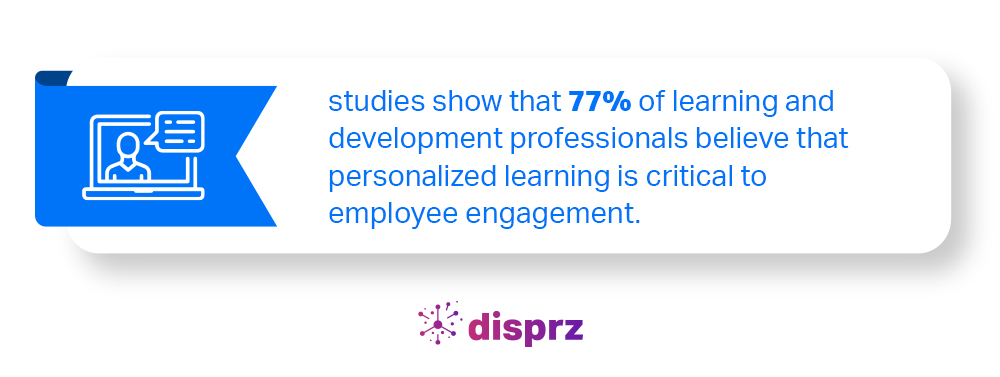Are employees really busy or are your learning programs disengaging?

The most common answers to the question ‘What is the reason for the low course completion rate?’ are ‘employees don’t have time to enroll in courses’ or ‘employees aren’t sincerely dedicating hours for learning’ or ‘employees are not interested in learning.’
However, as per a study:
- 94% of employees have said that they would happily stay in a company longer if it invested in their learning and development.
- 68% of employees prefer to learn at work.
- 74% of workers are willing to learn new skills or re-train to remain employable
- 54% of employees would spend more time learning if they had specific course recommendations to help them reach their career goals.
After reading the above statistics, can we still say that ‘employees are not interested in learning’ or ‘they don’t have time’?
When we step into the employee’s shoes and look at the L&D programs, the question comes up: Will they invest time in something that is not driving value or failing to hold their attention?
For instance, some employees might ignore a long PDF on ‘How to generate sales leads.’ However, if the same thing is presented in a two-minute video with interesting visuals, stats, and use cases, the learner might go ahead and complete the course. This points out the need for organisation to re-invent and innovate their learning strategies to truly engage their employees and steer their career growth journeys.
Five ways to make your learning programs engaging for capturing employee interest:
A few ways to improve your learning engagement rate and build that sustainable learning culture includes:
Take feedback and find the gap in current learning programs
You cannot complete a jigsaw puzzle until you find the missing piece. In the same way, try to find out what’s missing in your current L&D programs.
Mull over various learning metrics like L&D cost per employee, return on investment, learning experience satisfaction, course enrollment and completion data, learner drop off rate and employee performance post L&D programs. If the results are below expectations, dig deeper into the root causes to identify and address the red flags in real-time.
Just scratching the surface of the L&D data might not help; conduct an in-depth survey to garner feedback from the learners. Find out what changes employees would like to see in the current learning programs? Why are they not taking or completing the courses? Try to understand what employees are interested in learning. Which formats do they prefer?
Once you find the gaps and collect the feedback, the next step would be to work on a strategic plan to make the learning programs more valuable, interactive and engaging. Explore various L&D tactics to improve engagement rates and technologies that can help you convert L&D metrics into better learning outcomes.
Tailor learning programs to each employee’s needs through personalization
Personalisation is applied almost everywhere. Suddenly, while scrolling through the Facebook feed, an ad pops up based on our search history. Netflix recommends movies to help us find movies that interest us. We can get a full personalized song list based on our listening behaviors. The same personalization strategy can be used to engage learners and address their unique learning needs.
As per a survey, 93% of high performing organizations agreed personalized learning supports an employee in reaching professional goals more efficiently.
Personalized learning enhances skill development. It fosters a culture of continuous learning. With a cutting-edge tool like LXP, companies can create personalized learning journeys to upskill, reskill or crosskill employees. Moreover, an AI-powered LXP recommends relevant content based on the learner’s job role, skill gap, and interest.

Encourage diversity and boost adoption with multilingual learning
Crucial information often falls between the cracks when presented in an unfamiliar language. Do not let language be a barrier in learning.
Most of the frontline employees reside in tier 2 or 3 cities where regional languages work best. So if companies present the learning and development programs in their local language, they are highly likely to engage with it.
One of India’s premium wine producers tapped into regional learning with the Disprz skilling suite. They created courses in Marathi for their factory workers in Nashik and witnessed a surge in adoption. This proves that you can seamlessly boost engagement by driving learning programs in the languages your employees understand.
Boost collaborative productivity with social learning
Modern learners are in a landscape that’s rapidly evolving. Whether it's industry trends or company products, everything is changing quickly. One of the best ways to fuel engagement is by giving your employees a platform to collaborate through social learning. Employees can share documents, information, and tactics that are effective. Moreover, managers can keep employees updated about new products and policies.
Most modern learning solutions offer a social wall where employees can easily start a discussion thread to address challenges or share resources to expand their skill set. Social learning opens doors to new opportunities to collaborate, share new ideas, learn from each other and grow together as a team.
Merge gamification with your learning strategy to increase engagement
Gamification has the power to amp up engagement and makes learning exciting. Employees are often stuck in a mundane routine. Gamification helps employees in learning something new while having fun. For instance, with Disprz Gameinar, you can conduct interactive learning sessions through polls, quizzes and breakout rooms.
Moreover, you can use leaderboards and badges to boost competitiveness while learning. Employees are encouraged to learn more and perform better to improve their ranks. Features like sticky notes and text wall help you take feedback of the learning session to spot and identify the roadblock in real-time.
An agile and engaging learning and development program can motivate employees to interact with the courses and complete them to improve their skill set. So dig deeper into your learning processes and try to find out the areas of improvement at the right time. You can assess the effectiveness of your learning process through the Disprz Learning Maturity survey and get recommendations to make the learning experience more effective and engaging for your employees.







